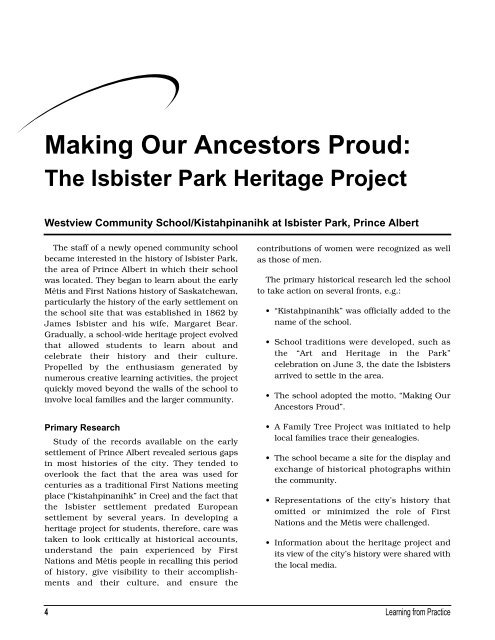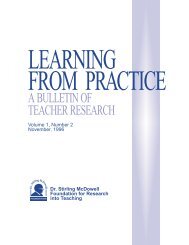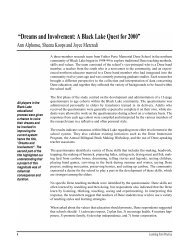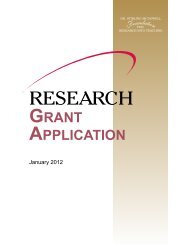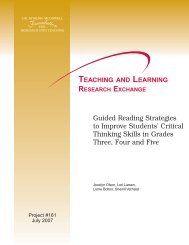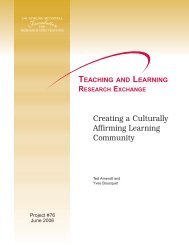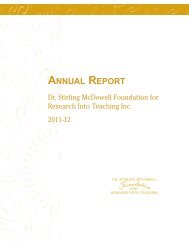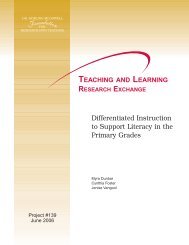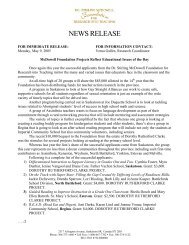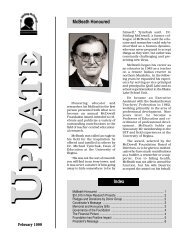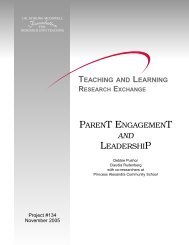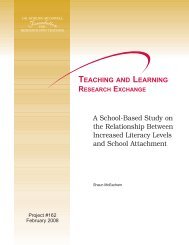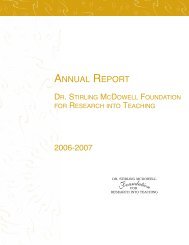Making Our Ancestors Proud: - Dr. Stirling McDowell Foundation for ...
Making Our Ancestors Proud: - Dr. Stirling McDowell Foundation for ...
Making Our Ancestors Proud: - Dr. Stirling McDowell Foundation for ...
Create successful ePaper yourself
Turn your PDF publications into a flip-book with our unique Google optimized e-Paper software.
<strong>Making</strong> <strong>Our</strong> <strong>Ancestors</strong> <strong>Proud</strong>:The Isbister Park Heritage ProjectWestview Community School/Kistahpinanihk at Isbister Park, Prince AlbertThe staff of a newly opened community schoolbecame interested in the history of Isbister Park,the area of Prince Albert in which their schoolwas located. They began to learn about the earlyMétis and First Nations history of Saskatchewan,particularly the history of the early settlement onthe school site that was established in 1862 byJames Isbister and his wife, Margaret Bear.Gradually, a school-wide heritage project evolvedthat allowed students to learn about andcelebrate their history and their culture.Propelled by the enthusiasm generated bynumerous creative learning activities, the projectquickly moved beyond the walls of the school toinvolve local families and the larger community.Primary ResearchStudy of the records available on the earlysettlement of Prince Albert revealed serious gapsin most histories of the city. They tended tooverlook the fact that the area was used <strong>for</strong>centuries as a traditional First Nations meetingplace (“kistahpinanihk” in Cree) and the fact thatthe Isbister settlement predated Europeansettlement by several years. In developing aheritage project <strong>for</strong> students, there<strong>for</strong>e, care wastaken to look critically at historical accounts,understand the pain experienced by FirstNations and Métis people in recalling this periodof history, give visibility to their accomplishmentsand their culture, and ensure thecontributions of women were recognized as wellas those of men.The primary historical research led the schoolto take action on several fronts, e.g.:• “Kistahpinanihk” was officially added to thename of the school.• School traditions were developed, such asthe “Art and Heritage in the Park”celebration on June 3, the date the Isbistersarrived to settle in the area.• The school adopted the motto, “<strong>Making</strong> <strong>Our</strong><strong>Ancestors</strong> <strong>Proud</strong>”.• A Family Tree Project was initiated to helplocal families trace their genealogies.• The school became a site <strong>for</strong> the display andexchange of historical photographs withinthe community.• Representations of the city’s history thatomitted or minimized the role of FirstNations and the Métis were challenged.• In<strong>for</strong>mation about the heritage project andits view of the city’s history were shared withthe local media.4Learning from Practice
Action ResearchData about the impact of the heritage projectwas gathered from journals that staff keptthroughout the project, reflection opportunitiesat staff meetings and planning sessions, writers’retreats <strong>for</strong> staff and parents, student writingand discussions, feedback from communityagencies, and tapes of celebrations, events andmeetings. Analysis of the data revealed fourmajor themes:1. Innovative Teaching/Experiential LearningThe children’s quest <strong>for</strong> knowledge of thepast, because of hands-on experience, hasincreased dramatically.– Parent commentBased on a curricular framework andobjectives developed <strong>for</strong> the heritage project,numerous learning activities were developed<strong>for</strong> the school and the classroom. Theyincluded painting a mural to <strong>for</strong>m a pictorialtimeline of the area’s history, making a modelof a river lot in the Isbister settlement, sewingperiod clothes <strong>for</strong> a dress-up trunk, makingbooks that told the stories of the Isbistersettlers, using the “storyline” strategy to helpstudents experience history, and workingwith a drama instructor and students fromthe Saskatchewan Urban Native TeacherEducation Program in a demonstrationproject on contextual drama. Through theproject, valuable lessons were learned aboutthe power of innovative teaching strategiesand the importance of experiential learning<strong>for</strong> student engagement.2. Genuine Interest/Engagement in LearningI saw the students wanting to participate,even the shy ones. I saw their true emotionsshowing through as if they were really there.– SUNTEP student commentThe most important and common theme thatemerged from the project was the genuineinterest that students had in learning abouttheir heritage. Teachers, parents andcommunity members recognized that thestudents were engaged in learning, and theirengagement fed the enthusiasm <strong>for</strong> the project.3. Pride in Seeing Oneself as Part of History/<strong>Making</strong> HistoryIt was seeing pride and the unspooling of apersonal history, a connection to the pastand to ancestors and a feeling of being morethan just an isolated self.– Teacher commentAs the project continued, pride in theheritage of the community served by theschool began to blossom. Students, staff andparents expressed their pride in being Métis,Cree or a resident of Prince Albert. Theschool’s Métis and Pow Wow dancers were ingreat demand and students were invited tosing the songs they had written in theLegislative Building in Regina. Parentalinvolvement in the project grew to the extentthat it became the most significant aspect ofthe final year.4. ConnectednessI have learned that mostly everyone is familycause in some way we’re all related. Ilearned that people’s cultures are different abit from each other and it doesn’t matter thatwe’re the same culture or different.– Student commentAs the school began to display family treesthat connected students to famous ancestors,a sense of connectedness developed amongfamilies, the school and the community. Anew sense of belonging grew from a sharedhistory.Learning from Practice 5


